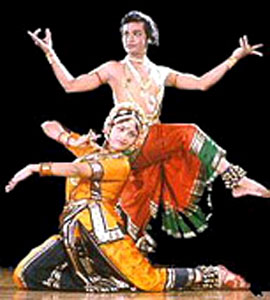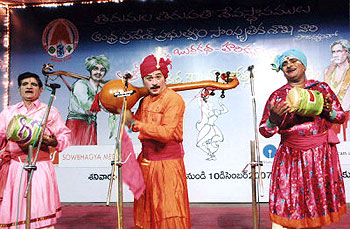 Culture of Nalgonda district lies in the traditions and customs that have been passed down through the generations. Over centuries, these have found expression in the art, language, dance, music and social customs of the place, unique to that region alone. The performing arts, particularly the theatre, are especially significant in preserving and transmitting the culture of a place. The culture of Nalgonda district finds expression through all these various means. Nalgonda district is famous for its religious, linguistic and traditional diversities.
Culture of Nalgonda district lies in the traditions and customs that have been passed down through the generations. Over centuries, these have found expression in the art, language, dance, music and social customs of the place, unique to that region alone. The performing arts, particularly the theatre, are especially significant in preserving and transmitting the culture of a place. The culture of Nalgonda district finds expression through all these various means. Nalgonda district is famous for its religious, linguistic and traditional diversities.
In the field of drama and theatre, plays dealing with mythological themes from the Ramayana and the Mahabharata are greatly enjoyed and appreciated. The Harikatha is another popular art and provides enjoyment and edification particularly to the elderly and devoutly inclined. Veedhinatakam or street drama in which the characters sing and dance throughout the night is another traditional art which has retained its popularity. The Burrakatha which is a ballad sung by a minstrel to the tune of a single - stringed Tambura and tiny drum grips both the urban and the rural people so wonderfully that its popular appeal has been exploited by the Government to spread the meaning and message of the plans and also by the political parties to spread their ideologies.
There are also a number of rural dances and games, of which Kolatam by girls is a popular dance. Among the classical arts, confined largely to urban life are the Bharatnatyam and Kuchipudi styles of dance and Carnatic music. The musical instruments largely in use are the Violin, Flute, Veena and Mridangam. Hindustani music, an art which was introduced into the district during the time of the Peshwas is also practised in many parts of the district. The lambada dance and the hand-clapping dance are very popular in rural areas. The Holi Dholandi is the traditional dance of the Lambada women. They sing quite gaily and dance prettily; the songs are in their own language and mostly in praise of Lord Krishna. In some places Pigeon flying is a popular pastime. In some place where important public offices are located, the employees have their recreation clubs.
 In the community life of the region, there is seen a in diversity though the external pattern of life of all the communities is becoming increasingly uniform under the Socio-economic stresses of modern living, each community has its own particular way of life, distinguished by varying manners and customs. All the communities co-exist in harmony and follow their beliefs and customs. Pilgrimages to holy shrines is a custom common to all three major religious groups.
In the community life of the region, there is seen a in diversity though the external pattern of life of all the communities is becoming increasingly uniform under the Socio-economic stresses of modern living, each community has its own particular way of life, distinguished by varying manners and customs. All the communities co-exist in harmony and follow their beliefs and customs. Pilgrimages to holy shrines is a custom common to all three major religious groups.
The culture of a place is also inherent in the dressing style of the people belonging to that place. Among the Hindus and Christians men commonly sport a Dhoti and Kurta. The younger folk of all communities, however, wear pants and shirts, The Muslims normally wear pyjamas and instead of dhoties and Kurta and the fez cap which however is not so common now. The women of all communities including Muslims wear saris and blouses (Ravikulu). Salwar Kameez are also worn by some Muslim women. The Lambada men have adopted the regional dress but the women folk have to this day retained their attractive colourful and heavy garments.
Hindu women wear the Bottu, The vermillion mark on the forehead. Some of the Christian women, particularly, the Catholics also put on the Bottu. Among the most treasured ornaments of married Hindu women are the Tali and Mattelu (Silver rings on the toes) because these ornaments are the seal and symbol of married status and are discarded only in the unfortunate event of widow-hood. The Lambada women are laden with ornaments, the horn bangles and the peculiar shaped anklets, which are heavy, attractive and most characteristic.
There is seen a comfortable harmony existing between the various communities living in the district. Almost all the festivals typical to the different communities, such as Diwali, Sankranti, Id ul Fitr, Bakrid, Christmas and Easter are celebrated here. A festival typical to the Telegus is the Ugadi. It is celebrated as the New Year Day of the Telugus usually occurring in March - April (Chaitra Suddha Padyami). Ugadi festival is characterised by the reading of significant passages from the New Years Panchangam (almanac). Feasting, common to all festivals is of course there.
Jatra and fairs are held in all parts of the district. These are annual occasions celebrated in reverence to a local God or Goddess. Urs are also organised on certain religious occasions. All these make the festivals and celebrations a much awaited affair of mirth and joy.
The culture of Nalgonda district can thus be seen contained in all these various features.



















